
In February 1930, Charles Mintz did something rather unusual: He hired a private railroad car to transport his staff from Manhattan to Los Angeles, relocating an entire animation studio from one coast to the other.
A bit over 87 years later, I took a plane from San Francisco to LA and visited Mintz’s first west-coast headquarters (at 1154 N. Western Ave.) and second one (at 7000 Santa Monica Blvd.). I also dropped by 861 Seward St., which is where Columbia moved the studio, by then known as Screen Gems, after Mintz’s death. Between the photos I took and the stuff I’ve dug up about these three buildings, I have too much information for a single post. So let’s start at the beginning with the story of the building where Scrappy was born.
Once upon a time–as I learned from an excellent article by Robert Peters–there were five brothers from Akron who had moved to Hollywood in 1913 with their mother. Their names were Irving, Raymond, Park, Paul, and Frank Ries, and they all found work relating to photography and the movie business.
Irving, the eldest, had his identity stolen by a German spy who was executed during WWI; was cameraman for The Lucky Dog, the first film featuring both Stan Laurel and Oliver Hardy; and eventually became a distinguished special-effects man who worked on the Gene Kelly/Jerry Mouse segment of Anchors Aweigh and Forbidden Planet. Frank, the youngest, ran his own photography studio which was actually a front for an operation which produced prodigious quantities of stag films; after arrests and jail time, he committed double suicide with his wife in a Chicago hotel room in 1947.

As for Ray, Park, and Paul, they founded a camera store/photo lab catering to the film industry, which was such a success that in late 1925 they began construction on a new $75,000 home for it at the corner of N. Western Ave. and Virginia Ave. The groundbreaking ceremony featured celebrities such as Baby Peggy–who, remarkably, is still with us. The new location officially opened on May 1, 1925, with festivities that attracted everyone from Priscilla Dean to Pal the Wonder Dog, the pooch who played Our Gang’s Pete the Pup.
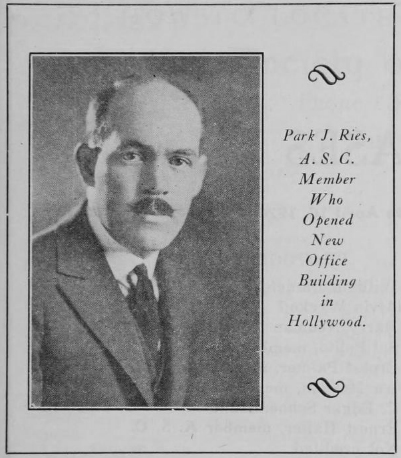
Besides their own operations–ranging from a portrait studio to a camera repair department–the Ries Bros. Building included 19 offices on its second floor designed to be rented out to other film-related businesses. Among the clients were Disney animators Hugh Harman and Rudolf Ising, who, as Mike Barrier recounts in Hollywood Cartoons, took space in the building for two weeks in September 1926, during a studio vacation, and produced a cartoon called Aladdin’s Vamp with their Disney colleagues Ub Iwerks and Rollin Hamilton. In 1928, Hugh and Rudy returned to the building for about a year to produce Oswald the Rabbit cartoons for Charles Mintz, after the latter’s legendary break with Walt Disney.
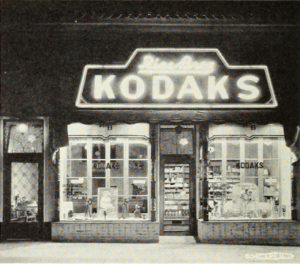
The Ries store’s time on N. Western Ave. was short-lived: Less than four years after it moved in, the brothers relocated it to Cahuenga Ave. (They also began producing wooden tripods which won the favor of notables such as Ansel Adams and are still available today.) But at roughly the time they left in 1930, Charles Mintz’s studio–still known at the time as the Winkler Film Corp.–rented a second-floor suite. Given that Mintz and his brother-in-law and associate George Winkler were well aware of the building from the brief period when Oswalds were produced there, it’s no surprise that they chose it for their newly-relocated studio, which got busy making Krazy Kat and Toby the Pup shorts–and, starting in 1931, the Scrappy cartoons of Dick Huemer, Sid Marcus, and Art Davis.
I don’t have any photos I know for sure to depict the interior of the Mintz studio at 1154 N. Western, but there’s presumably a decent chance that this one–from Dr. Richard Huemer’s Huemer.com, showing Jack Carr, Sid Marcus, and Dick Huemer with Toby–was taken there.
As for the exterior, we do have some shots of Mintz staffers hanging around outside the building, thanks to Mark Mayerson. In 2006, Mark shared a photo sent to him by Paul Spector, the son of animation-industry veteran (and Mintz employee) Irv Spector.

That’s Irv second from the left. Mark guessed that the photo might show Al Gould third from right, Felix Alegre second from right, and Ed Solomon at right. They’re standing in front of the door to 1154 N. Western, which led up to the studio and other tenants; the “entrance” sign is tantalizing, but I’m not sure what it’s for. (As quoted in Hollywood Cartoons, Mintz inbetweener Don Patterson said there was a pool hall downstairs, possibly in space the Rieses has vacated when they relocated their store to Cahuenga.)
Way back in the last century, Mark also posted some 1154 N. Western exterior shots from the collection of Al Eugster, showing Al with fellow Mintz artists.
In the top photo, from left to right: Al Eugster, Manny Gould, Allen Rose, and Harry Love. On the bottom, from left to right: Harry Love, Preston Blair and Allen Rose, with Al Eugster in front.
Mintz’s move west was followed by expansion: In December 1931, the Film Daily reported that the studio had tripled its staff and doubled the size of its quarters. Most likely, it was a need for even more space that prompted the company to move from 1154 N. Western Ave. to 7000 Santa Monica Blvd, where it could occupy a building of its own. When I wrote about that address, I published a staff photo taken there marked “1932.” But I’ve since come across a want ad placed by Mintz artist Ben Harrison, offering a reward for his lost music manuscript. It’s dated December 21st, 1932, and lists the N. Western Ave. address; if the studio left that building in 1932, it must have done so at the very end of the year.
Whatever the year, the Mintz operation did move out in the early-to-mid 1930s, and the building is still there in 2017. What has it housed for the last 80-plus years? Funny you should ask.
In 1934, someone located there was selling a mysterious electrical device of interest to beer parlors and restaurants.
 In 1935, a director sought girls and children for a new production, which sounds like a likely story to me.
In 1935, a director sought girls and children for a new production, which sounds like a likely story to me.
In 1937 you could write to 1154 N. Western for a free booklet on the secrets of songwriting.
That same year, another tenant had a need for salesman to hawk the “sweetest oil deal that has ever hit L.A.”
 More salesmen were needed in 1939 for an unspecified purpose.
More salesmen were needed in 1939 for an unspecified purpose.
In 1942, a company called Champion sold its “battery rejuvenator” from the address.

In 1946, there was a business at 1154 N. Western that wasn’t as far-flung from what we talk about here at Scrappyland as most: Telecomics, which might have beat Jay Ward and Alex Anderson’s Crusader Rabbit to be the first made-for-TV animation if it had made its drawings, you know, move. (It was headed by Dick Moores, who drew Disney comics and was eventually best-known as the wonderful writer and artist of Gasoline Alley.)
In 1950, there was a steam-heat business there.
In 1954, a company in the building wanted to finance and promote inventions
In 1962, a school operated out of the building taught the noble science of shoe fitting.
In 1968, you could write to 1154 N. Western to get yourself a Russian pen pal.
In 1974, a syndicated newspaper column called “Kanine Korner” used the building as its mailing address.
In 1987, a landlord accused of treating tenants poorly was sentenced to perform community service at 1154 N. Western.
And at the same time, you could go to see movies about the Soviet Union.
Maybe any random office building that’s been around for more than ninety years has had a similarly eclectic list of tenants. But I’m still fascinated by the sheer randomness of occupants, in a structure originally catering solely to the film industry.
What was going on in the downstairs retail area over all these decades, I’m not sure. But in recent years, as shown in the Yelp photo below, the space had housed a party-supply shop and a market. If you squint, you can make out a Mickey Mouse poster in the market’s window, which is some sort of karmic commentary on the respective legacies of Walt Disney and Charles Mintz.
Anyhow, fast-forward to last week. Here’s what the Ries Bros. Building currently looks like.
The neighborhood that apparently had its fair share of Hollywood pizzazz in the 1920s has kept its buildings but lost its glamour; on the morning I was there, I couldn’t tell whether many of the retail businesses in the area were still extant or not.
On the ground level of the Ries Bros. Building, where the brothers’ camera store once operated, I found something called The Unincorporated Life which I thought might be a defunct bar. Turns out that it’s a still-in-business fashion school with a mascot who has a bit of a Mintz-esque look.
In fact, the Unincorporated Life robot looks like a relative of the ones in the Scrappy cartoon Technoracket (1933). A coincidence, presumably, but a happy one.

Upstairs are several businesses, including a moving company, an insurance agent, and (retaining a tenuous link to the building’s showbiz past) a video-production facility. Perhaps one of them is in the space once used by the Charles Mintz studio. Or the studio’s precise quarters may currently be unoccupied: There’s a “For Lease” banner hanging off the balcony that’s been there for years.
I didn’t attempt to go inside–for one thing, several of the current occupants had signs requesting visitors not to ring the bell–but standing on the pavement, I tried to visualize what Charles Mintz’s young employees might have seen from the area immediately outside their place of business. They might well have had a splendid view of the not-yet-iconic Hollywoodland sign; now the Hollywood sign, it’s blocked rather precisely by a nearby billboard that may not have been there 85 years ago. (I hope no Mintz staffers witnessed the suicide of Peg Entwistle, a young actress who jumped off the “H” in 1932.)
A few doors down from 1154 N. Western is Stewart Plumbing, which says it’s been in the same building since 1920, and looks like it’s hardly changed at all. I can’t quite tell whether its current sign is visible in Mark Mayerson’s photo of Irv Spector and colleagues, which does show the Stewart building in the background. But it’s certainly easy to envision the Mintz studio calling in its neighborhood plumber to deal with any clogged drains it might have had.
As seen in my photo above, 1154 N. Western is just around the corner from 5454 Virginia Ave., where the Mintz staffers gathered for some photos made famous–at least to hardcore 1930s cartoon fans–by Joe Campana’s wonderful blog post “Ghosts of the Charles Mintz studio.” I didn’t see any signs that the building, which was originally a furniture store and later became a non-denominational church and then a synagogue, is currently occupied. But as I snapped photos, I did mystify a man seated in his parked car, right where the Mintz photos were taken.
Here’s the Mintz staff lined up for their team photo, circa 1930 or 1931.
And here’s that 1926 rendition of the new Ries Bros. Building again, along with a Google Maps image capturing the same view in February of this year. For all that’s changed, I’m glad it’s still there and wish its current inhabitants well. Even if none of them have a clue that Scrappy cartoons were once made on the premises, as seems probable.
See you soon with news of my visit to 7000 Santa Monica Blvd, a place with a history all its own–and tenants who, I’m pleased to report, are well aware of their building’s Mintz legacy.


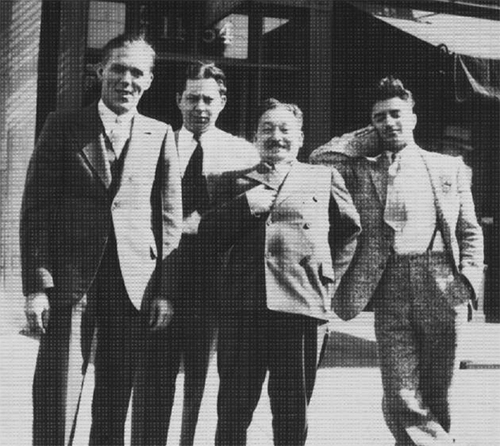





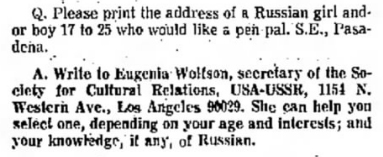



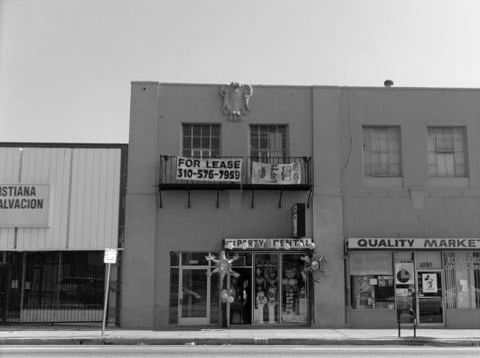


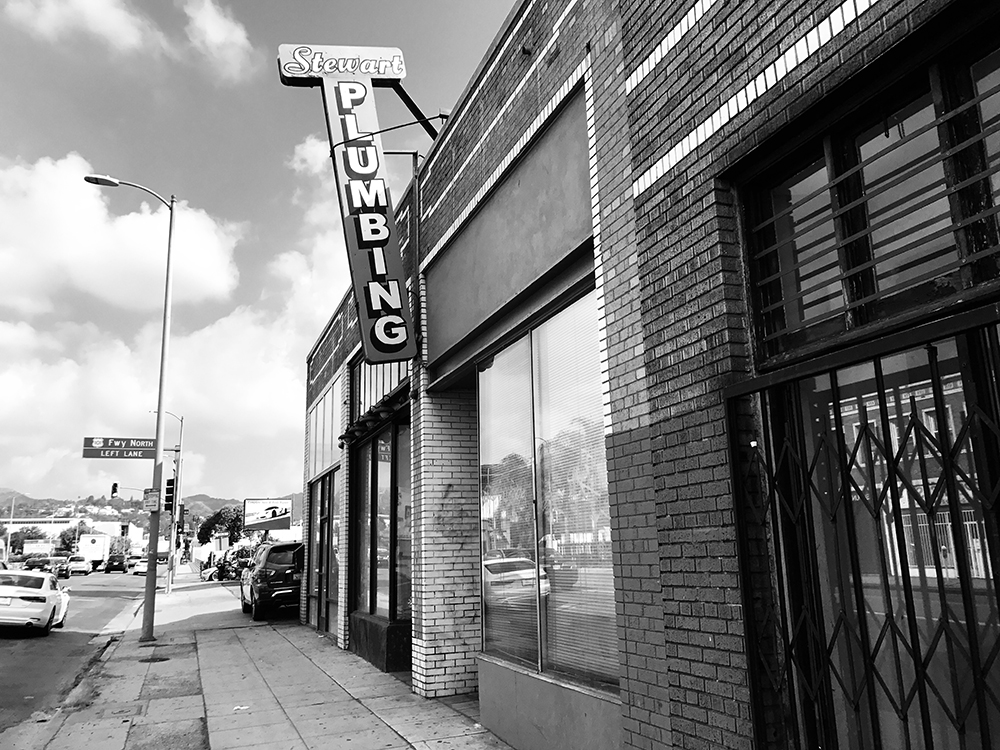


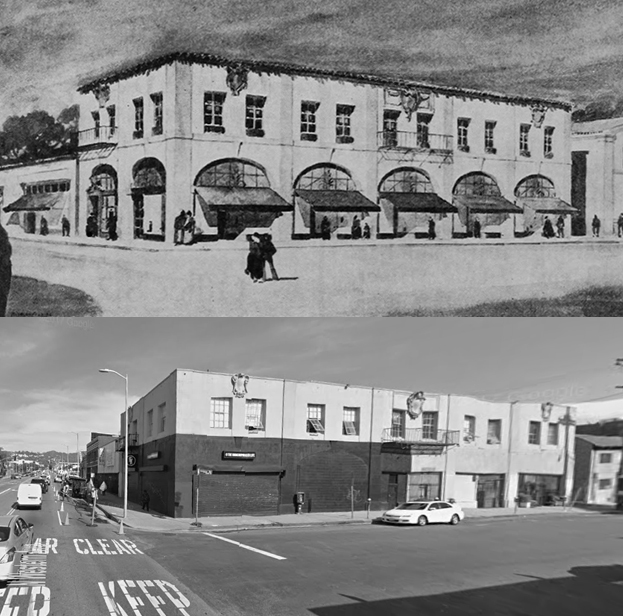
Such an impressive research job, and what fun! This helps me understand my Dad’s timeline, too. I did a “take” when I encountered “Technoracket”–did HM misspell a title? No; he cited a title that’s nearly an anagram of another 1933 title, “Techno-Cracked”, from Iwerks’ studio. I last glimpsed Technocracy adherents, trying to sign up new converts, in the parking lot of Hughes Market of Granada Hills, circa 1970.
I had to look up the name of the Scrappy cartoon to make sure it wasn’t Techno-Cracked. It’s fascinating that the meme was in the air enough back then to have inspired at least two cartoons.
Wow. Thank you for the in depth history of this building. We’re current tenants that just moved in. We’re about to open up our little photo studio on the second floor. The previous tenant used the space as his painting studio. The Russian abstract painter Sergei Tivetsky. We have been so curious about the building. We had no idea of the buildings amazing history. We hope the good will and creative energy of the studio and camera shop lifts our little space up! It’s called Rad Place and is set to open in the next few weeks. Send us your email for an invite to the party.
Today I just received my 50th anniversary copy of Creem Magazine (a rock and roll magazine from the 60s). They list their shipping address as 1154 N Western Ave Ste 1.
Thank you for this amazing research you did. I just rented one of their spaces a few months ago, my business is an R&D Cosmetic Lab for indie businesses. I loved getting to know a bit more about the building’s history.
This is truly amazing research! Thanks for doing the digging, writing and posting. I’m particularly interested in Irving Ries, as photographer of “The Lucky Dog.” Thanks to you, I now know what he looked like.